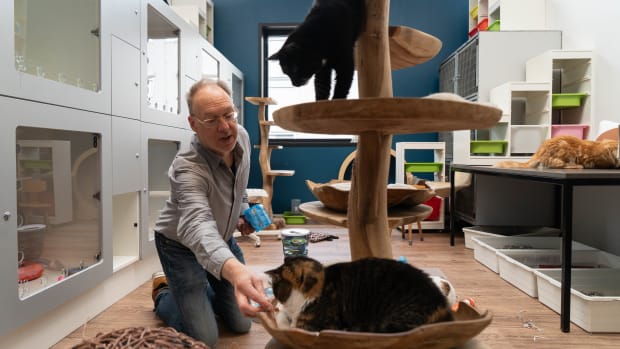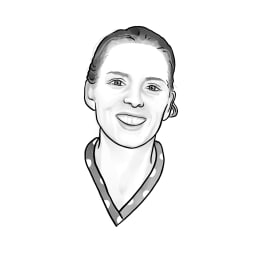
Animal-human scientist Maarten Reesink: “I am a cat, born in a human body”
Since Flodder came to live with him, the life of animal-human scientist Maarten Reesink has been inextricably linked to that of the cat. On World Animal Day, October 4, he releases his masterpiece: Planeet Poes (Planet Cat). “This is my happiest book yet.”
Arriving at the Amsterdam Stray Cats Foundation (SAZ), animal-human studies researcher Maarten Reesink wants to first see the cats. With a bag of cat treats in his hand, he closely watches how the twenty-five cats in the room react. A red cat cautiously eats a treat from his hand. “That’s a good sign; she didn’t dare to do that last week.”
Every week, Reesink helps the SAZ’s stray cats to “socialise”. This time, things are different because his new book, Planeet Poes (Planet Cat), is being published on World Animal Day. The first copy goes to Jans Stroeve, the big “boss” of the stray cat centre. She accepts it modestly. “That green at the cover is lovely. And is your next book about the people behind the cats?”
“Jans loves publicity as much as I do,” jokes Reesink, who receives several calls from the national press during the interview with Folia. He understands: there are around 3.1 million domestic cats in the Netherlands, so it’s a popular topic for the newspapers, he rationalises. “It’s nice, but I’ll be glad when it’s over.”

Reesink prefers to sit quietly among the cats. “Ironically, that’s the only thing I don’t have in common with cats,” Reesink notes. “Cats themselves prefer to be alone. Cats are the only solitary creatures among domesticated animals, except for hamsters.”
Otherwise, Reesink has many similarities with the four-legged creatures. “I often joke with my students that I am actually a cat born in a human body. I am not very sociable. I like time to myself. I like to sleep in and work in the evenings and at night.” Sitting at a table overlooking the cat enclosures, Reesink explains how this came about.
Flodder
“We got Flodder when I was about six years old. A whole new world opened up for me. I had never thought much about animals before, but I immediately developed a fascination for animals in general and cats in particular. I still think cats are by far the most brilliant animals.”
“I found Flodder a very intriguing creature. She wasn’t immediately dependent but had a mind of her own. I can still see myself walking after her, between the greenhouses on the farmland near Breda where I grew up. I wanted to know what her life was like.”
“Flodder immediately became my cat. She slept in my room. She turned me into a cat person. Research shows that the animal you grow up with is ultimately the most decisive factor in whether you are a dog person or a cat person.”
“My fascination with animals remained, even as I got older. After a visit to Artis Zoo, I knew what I wanted to do for a living: be a lion keeper. When the end of my time at grammar school was approaching, my parents saw me heading in the wrong direction and started to make it clear to me: you can’t do grammar school and then become a lion keeper. So I chose biology.”
Love at first sight
“When biology turned out to be mainly about cells, I switched to communication sciences. Later, I taught media studies. In 2005, I read a student’s thesis that changed my life. The thesis was about American nature documentaries from the 1940s and 1950s, and after a quick Google search, I saw that a lot of books had been written about nature documentaries. In the 1980s and 1990s, a new field of study had even emerged in England and America: human-animal studies.”

“Within an hour, I knew: this is what I’m going to do for the rest of my life. You know the saying, love at first sight. I’ve never experienced that in love, but I did with this field of study. Everything came together: the fact that I had studied science, had done a humanities degree and was now working at a humanities faculty and could focus on my great love: animals.”
“In three years, I had read every book I could find on animal-human studies. It is one of the fastest-growing fields at universities worldwide. In my spare time – many people think I’m a weirdo – I often read very complicated articles about why the dental formula of sabre-toothed cats has changed and what that says about their spread across the world.”
“Then I started teaching and wrote a Dutch-language introduction to the field. I wanted to apply all that knowledge to my favourite animal: Flodder. Planeet Poes is the book I always wanted for myself: a complete encyclopaedia of everything we know about cats. I don’t think I’ll ever experience anything that makes me happier in my life.’
Maarten Reesink works in the media studies department at the University of Amsterdam and is co-founder of the Centre for Animal-Human Studies, which investigates the relationship between humans and animals. Since 2008, he has been teaching the elective course Animal-Human Studies at the University of Amsterdam.
For as long as he can remember, Maarten Reesink has lived with cats – except during his time as a student when he lived with a landlady. After reading a scientific article by rabbit researcher Julie Ann Smith, who spent two days moving around the house with her head at a maximum height of twenty centimetres, he now considers what his cat Ritsel will be able to do with every new piece of furniture he buys. “A cat must be able to climb into things, hide behind things and, above all, be on top of things.”
“Cats are the love of my life, you can write that down. Theo van Gogh is said to have once remarked: at the end of your life, you should be able to sum up what your life was all about in one sentence. For me, that’s cats.”
What’s in animals’ minds
“I’ll be taking a break for the next six months, because I’ve really had enough of writing for now. But I am already thinking about the next book: what goes on in animals’ minds. Research has shown for a long time that animals understand much more than we realise. We just need a translator. Researchers predict that in ten to fifteen years, AI will enable such a translation system. I think it’s quite likely that we’ll succeed one day.”
“What will I ask my cat Ritsel? Whether she can live with being an indoor cat. I realise that this is a limitation in her life. And whether she appreciates the attention I give her and also enjoys living together.”
Maarten Reesink, Planet Cat: From sabre-toothed cats to internet kitties. (Noordboek, 2025). ISBN 9789464713800 Price €24.90


